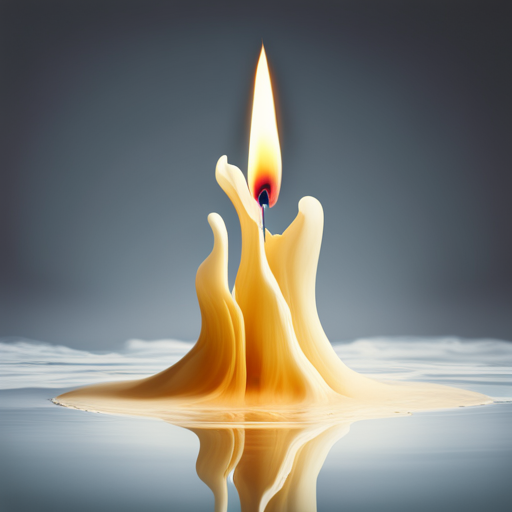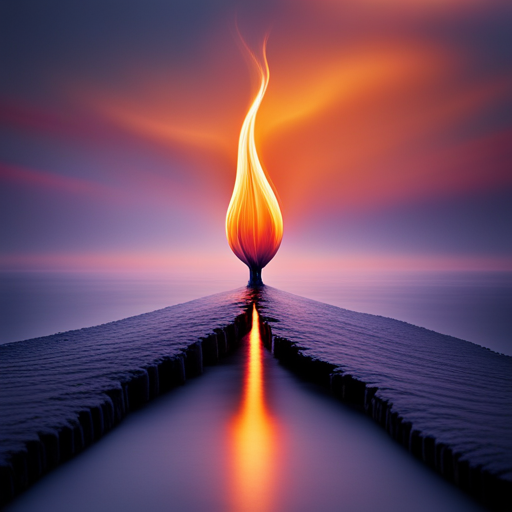When a candle burns, the heat from the flame causes the wax to melt and be absorbed by the wick. Eventually, the molten wax in the wick evaporates and burns, sustaining the flame.
Factors such as the type of wax, its thickness, and the ambient temperature can affect the time it takes for wax to liquefy and evaporate.
Let’s explore the science behind this fascinating process.
Key Takeaways
– Wax in a candle disappears as it is burned and carried away by the wick.
– The melting point of wax determines when it transitions from a solid to a liquid state.
– The rate of evaporation of candle wax depends on factors such as the type of wax and the size of the candle.
– Evaporation is the process by which wax changes from a liquid to a gas or vapor.
Reasons Behind Wax Disappearing in a Candle

https://www.youtube.com/watch?v=B9asozzeAwY
The heat from the flame of the candle melts the wax, allowing it to be absorbed by the wick and eventually evaporate, causing the wax to disappear in a candle.
As the flame burns, the heat is transferred to the nearby wax, causing it to liquefy. The liquid wax is drawn up the wick through capillary action, where it is exposed to the heat of the flame. This heat causes the liquid wax to vaporize and burn, sustaining the flame.
Over time, the wax is consumed, and the candle gradually diminishes in size. The disappearance of the wax is a result of the continuous process of melting, absorption, and evaporation.
Melting Point of Candle Wax

The melting point of candle wax determines when it transitions from a solid to a liquid state.
– Candle wax melts at different rates depending on temperature, typically ranging from 80 to 200 degrees Fahrenheit.
– Factors such as the type of wax, its thickness, and the ambient temperature can affect the time it takes for wax to completely liquefy.
– Pure beeswax has a higher melting point compared to other types of wax, requiring a higher heat source to melt.
– The melting point of wax determines the temperature at which it starts to melt and become available for evaporation.
Understanding the melting point is crucial in controlling the burn time and evaporation rate of a candle. Different types of wax have varying melting points, which influence the overall performance and lifespan of the candle. By knowing the melting point, candle makers can create candles that burn efficiently and evenly, providing both aesthetic appeal and longer-lasting burn times.
Factors Affecting the Melting Point of Wax

Factors affecting the melting point of wax include the type of wax used, thickness, and ambient temperature.
The type of wax used plays a significant role in determining its melting point. For example, pure beeswax has a higher melting point compared to other types of wax.
The thickness of the wax also affects its melting point, as thicker wax requires more heat to reach its melting point.
Additionally, the ambient temperature can influence the melting point of wax. Higher temperatures can cause wax to melt at a faster rate, while lower temperatures can cause it to solidify.
These factors must be taken into consideration when using wax for various applications, such as candle making or wax sealing.
Rate of Evaporation of Candle Wax

Soft candle waxes evaporate at a slower pace compared to harder waxes due to their lower melting points. This is because the heat from the flame of the candle melts the wax, allowing it to be absorbed by the wick. The molten wax still in the wick eventually evaporates and burns, keeping the candle flame going.
Factors such as the type of wax used, its thickness, and the ambient temperature can affect the time it takes for wax to completely liquefy. The rate of wax evaporation varies depending on the melting point of the wax and the volume of the candle. Soft candle waxes have a slower evaporation rate compared to harder waxes.
Candle size, wax density, and additives incorporated into the wax can also affect the rate of evaporation.
Factors Influencing the Rate of Evaporation

Different elements, such as candle size, wax density, and additives, can impact the rate at which candle wax evaporates.
The size of the candle plays a role in how quickly the wax evaporates. Larger candles tend to have a longer burn time and slower evaporation rate compared to smaller ones.
The density of the wax also affects the evaporation rate. Denser waxes evaporate at a slower pace than lighter ones.
Additionally, additives incorporated into the wax can alter its evaporation rate. Certain additives, such as scent oils or colorants, can increase the evaporation rate, while others, like stearic acid, can slow it down.
Understanding these factors can help candle makers and consumers determine the burn time and overall lifespan of a candle.
Science Behind Candle Wax Evaporation

The heat from the candle’s flame causes the wax to transition from a solid to a liquid state, leading to its eventual evaporation. This process is known as candle wax evaporation, which involves the transformation of the wax from a solid to a gas or vapor.
There are several factors that influence the evaporation rate of candle wax, including the type of wax used, the size of the candle, and the ambient temperature. Additionally, the melting point of the wax plays a crucial role in determining the temperature at which it starts to melt and become available for evaporation.
As the molten wax is absorbed by the wick and burns, it releases heat and light, allowing the candle to continue burning until all the wax is consumed.
Phases of Matter and Wax Transformation

When exposed to heat from the candle’s flame, the wax undergoes a transformation from a solid to a liquid state, before eventually evaporating.
As the flame burns, the heat melts the wax, causing it to become a liquid. This molten wax is then absorbed by the wick, which acts as a fuel for the flame.
Over time, the liquid wax in the wick evaporates and turns into vapor, allowing it to be burned and contribute to the candle’s light and heat.
This process continues until the wax is completely consumed, at which point the candle will no longer be able to burn.
It is through this transformation from solid to liquid to vapor that wax disappears in a candle.
Evaporation Rate of Different Candle Wax Types

After understanding the phases of matter and the transformation of wax, it is important to consider the evaporation rate of different candle wax types. The rate at which wax evaporates can vary depending on the type of wax used and its hardness.
Here are some key points to consider:
– Soft candle waxes, like paraffin wax, tend to have a slower evaporation rate compared to harder waxes, such as beeswax.
– Paraffin wax, being a softer wax, burns more quickly than other types.
– Soy wax falls in the middle, with a medium hardness and an intermediate burn speed.
– Beeswax, known for its slow burn rate, is one of the hardest types of wax.
The type of wax used in a candle not only affects its burn time but also determines how quickly the wax will evaporate.
Impact of Wax Type on Burn Time and Evaporation Rate

Different types of candle wax have varying burn times and rates of evaporation. Factors such as wax hardness and composition influence these characteristics. The hardness of the wax is a significant factor in determining its evaporation rate. Soft candle waxes, like paraffin wax, evaporate more slowly compared to harder waxes like beeswax. The composition of the wax also affects the evaporation process. For example, soy wax, which has a medium hardness, evaporates at an intermediate rate. Beeswax, known for its slow burn rate, is one of the hardest types of wax and evaporates at a slower pace. These differences in burn times and evaporation rates make each type of candle wax unique and suitable for various purposes.
Can Candle Wax Evaporate Over Time?
Yes, candle wax decomposition explained– over time, candle wax can evaporate, especially in warmer temperatures. This process occurs as the wax molecules break down and turn into vapor. To prevent this, store candles in a cool, dry place to maintain their integrity and prolong their lifespan.
Frequently Asked Questions
How Does the Type of Wax Used in a Candle Affect Its Burn Time?
The type of wax used in a candle directly affects its burn time. Soft waxes have a slower evaporation rate compared to harder waxes, resulting in a longer burn time for candles made with harder waxes.
What Factors Can Affect the Rate of Evaporation of Candle Wax?
Factors that can affect the rate of evaporation of candle wax include the type of wax used, candle size, wax density, and any additives incorporated into the wax.
Can the Ambient Temperature Impact the Melting Point of Wax?
Yes, the ambient temperature can impact the melting point of wax. Higher temperatures can cause the wax to melt at a faster rate, while lower temperatures can make the wax harder to melt.
What Are the Different Phases of Matter That Wax Undergoes During Evaporation?
During evaporation, wax undergoes three phases of matter: solid, liquid, and gas. When heat is applied, it transitions from a solid to a liquid state, and eventually evaporates into a gas or vapor.
Does the Size of the Candle Affect the Rate of Wax Evaporation?
The size of the candle can affect the rate of wax evaporation. Larger candles tend to have a longer burn time and slower evaporation rate, while smaller candles evaporate more quickly due to their smaller volume of wax.

